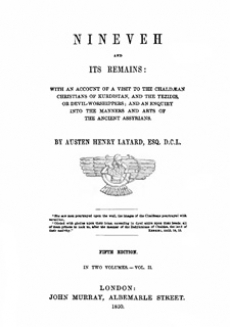| NINEVEH AND ITS REMAINS: with an account of a visit to the Chaldean Christians of Kurdistan, and the Yezidis, or Devil-worshippers; and an enquiry into the manners and arts of the ancient Assyrians
Volume II
As I was drawing one morning at the mound, Ibrahim Agha came to me, with his eyes full of tears, and announced the death of Tahyar Pasha. The Cawass had followed the fortunes of the late Governor of Mosul almost since childhood, and was looked upon as a member of his family. Like other Turks of his class, he had been devoted to the service of his patron, and was treated more like a companion than a servant. In no country in the world are ties of this nature more close than in Turkey : nowhere does there exist a better feeling between the master and the servant, and the master and the slave.
I was much grieved at the sudden death of Tahyar ; for he was a man of gentle and kindly manners, just and considerate in his government, and of considerable information and learning for a Turk. I felt a kind of affection for him. The cause of his death showed his integrity. His troops had plundered a friendly tribe, falsely represented to him as rebellious by his principal officers, who were anxious to have an opportunity of enriching themselves with the spoil. When he learnt the particulars of the affair, and that the tribe, so far from being hostile, were peaceably pasturing their flocks on the banks of the Khabour, he exclaimed, " You have destroyed my house," (i.e. its honour), and, without speaking again, died of a broken heart. He was buried in the court-yard of the principal mosque at Mardin. A simple but elegant tomb, surrounded by flowers and evergreens, was raised over his remains ; and an Arabic inscription records the virtues and probable reward of one of the most honest and amiable men that it has been my lot, in a life of some experience amongst men of various kinds, to meet. I visited his monument during my journey to Constantinople. From thelofty terrace, where it stands, the eye wanders over the vast plains of Mesopotamia, stretching to the Euphrates, — in spring one great meadow, covered with the tents and flocks of innumerable tribes.
The Kiayah, or chief secretary, was chosen Governor of the province by the council, until the Porte could name a new Pasha, or take other steps for the administration of affairs. Essad Pasha, who had lately been at Beyrout, was at length appointed to succeed Tahyar, and soon after reached his Pashalic. These changes did not affect my proceedings. Armed with my Vizirial letter I was able to defy the machinations of the Cadi and the Ulema, who did not cease their endeavours to throw obstacles in my way.
After the celebration of Christmas I returned to Nimroud, and the excavations were again carried on with activity.
I should weary the reader, were I to describe, step by step, the progress of the work, and the discoveries gradually made in various parts of the great mound. The labours of one day resembled those of the preceding. A mere journal of my proceedings would afford but little amusement, and I should have to enter, over and over again, into the same details, and should probably be led into a repetition of the same reflections. I prefer, therefore, describing at once the results of my labours during the first three months of the year; and I will endeavour to explain, as concisely as possible, the extent of the operations, and the nature of the buildings uncovered. It will be necessary to make frequent reference to the plans ; as, without the assistance they afford, it would be difficult to convey an accurate idea of the form of the edifices and position of the chambers.
The north-west palace was naturally the most interesting portion of the ruins, and to it were principally directed my researches. I had satisfied myself beyond a doubt that it was the most ancient building yet explored in Assyria. Not having been exposed to a conflagration like other edifices, the sculptures, bas-reliefs, and inscriptions, which it contained, were still admirably preserved... |
